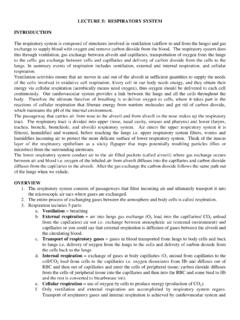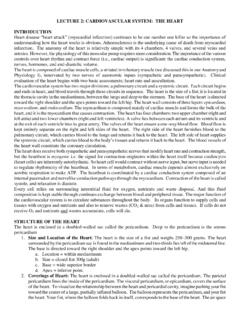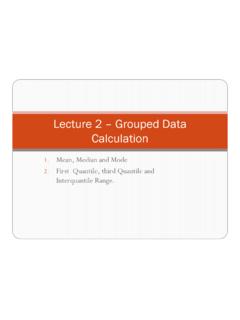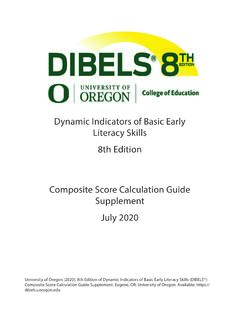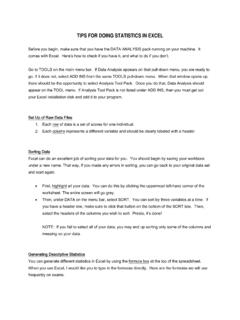Transcription of Chapter 5: Normal Probability Distributions - Solutions
1 Chapter 5: Normal Probability Distributions - Solutions Note: All areas and z-scores are approximate. Your answers may vary slightly. Normal Distributions : Finding Probabilities If you are given that a random variable X has a Normal distribution, finding probabilities corresponds to finding the area between the standard Normal curve and the x-axis, using the table of z-scores. The mean (expected value) and standard deviation should be given in the problem. For the Probability that X < b, convert b into a z-score using b . z=.. and use the table to find the area to the left of the z-value.
2 For the Probability that X > a, convert a into a z-score using a . z=.. and use the table to find the area to the right of the z-score. For the Probability that a < X < b (X is between two numbers, a and b), convert a and b into z-scores using a b . z= and z =.. and use the table to find the area between the two z-values. 1. The average speed of vehicles traveling on a stretch of highway is 67 miles per hour with a standard deviation of miles per hour. A vehicle is selected at random. a. What is the Probability that it is violating the 70 mile per hour speed limit? Assume that the speeds are normally distributed.
3 Solution: The random variable X is speed . We are told that X has a Normal distribution. The mean = 67 . The standard deviation = . We are looking for the Probability of the event that X > 70 . 1. Step 1: Convert 70 into a z-score: 70 67. z= Step 2: Find the appropriate area between the Normal curve and the axis using the table: The table contains cumulative areas (to the left of the z-value). The area cor- responding to a z-score of in the table is Since we are interested in X > 70, we need the area to the right of the z-score, thus P (X > 70) 1 (a) What is the Probability that a randomly selected vehicle is not violating the speed limit?
4 The z-score is the same: We are interested in P (X 70), thus the area to the left of this z-score can be read directly off the table: OR, using complements and the answer to part a, P (X 70) = 1 P (X > 70) 1 (b) What is the Probability that a randomly selected vehicle is traveling under 50. miles per hour? We are interested in P (X < 50). The z-score is 50 67 17. z= = The area needed is to the left of this z-score. Notice that is not even on the table, and the lowest z-score is , with a corresponding area of For z-scores less than , the area is even less than and very close to 0, and we may assume is approximately 0.
5 (The more accurate answer is about : about 1 in million Probability .). (c) What is the Probability that a randomly selected vehicle is traveling between 50. and 70 miles per hour? The z-score for 70 is with a corresponding area of The z-score for 50. is with a corresponding area of about 0. Thus, we subtract: P (50 < X < 70) 0 2. Practice Problem: A customer calling a call center spends an average of 45 minutes on hold during the peak season, with a standard deviation of 12 minutes. Suppose these times are normally distributed. Find the Probability that the customer will be on hold for each interval of times: a.
6 More than 54 minutes. Let X be the number of minutes the customer spends on hold. We want P (X > 54). The mean is = 45 and standard deviation is = 12. The z-score is 54 45 9. z= = = 12 12. The corresponding area is For P (X > 54), the area to the right is needed. Thus, P (X > 54) 1 = b. Less than 24 minutes. We want P (X < 24). The z-score is 24 45 21. z= = = 12 12. The corresponding area is For P (X < 24), the area to the left is needed. Thus, P (X < 24) c. Between 24 and 54 minutes. The z-score for 24 is with a corresponding area of , and the z-score for 54 is with a corresponding area of Thus, P (24 < X < 54) = d.
7 More than 39 minutes. We need P (X > 39). The z-score for 39 is 39 45. z= = 12. The corresponding area is We need the area to the right of the z-score. Thus, P (X > 39) 1 = 3. Normal Distributions : Finding Values Now the process from will be reversed. Starting with a Probability , you will find a corresponding z-score. The same table will be used, but you will search the center of the table to find the Probability first, and then determine the z-score that corresponds to that Probability . To make this easier, first draw a picture. 2. Find the indicated z-scores. Draw a picture and include a short explanation a.
8 The z-score that corresponds to a cumulative area of (the cumulative area is the area to the left of the z-score). Look for the given area in the table and find the corresponding z-score: b. The z-score that corresponds to of the distribution's area to its right. The table lists the cumulative area: to the left of the z-score. Thus, the z-score needed corresponds to a left area of 1 = This z-score is c. The z-score that corresponds to of the distribution's area to its right. First convert into a Probability (area): The z-score needed corre- sponds to a left area of 1 = This z-score is d.
9 The z-score that corresponds to the 90th percentile (P90 ) of the distribution's area. Convert 90% into a Probability (area) first: Even though this exact area is not in the table, pick the closest areas. The desired z-score is between and (You may use either of these or average them). Practice Problem: a. The z-score that corresponds to a cumulative area of From the table: z = b. The z-score that corresponds to of the distribution's area to its right. Find the z-score corresponding to area 1 = This is c. The z-score that corresponds to of the distribution's area to its right. Convert into a Probability : , and find the z-score corresponding to area 1 = This is d.
10 The z-score that corresponds to the 30th percentile (P30 ) of the distribution's area. Convert 30% into a Probability : , and find the z-score corresponding to this area: between and 4. Transforming a z-score into a data value Given a z-score, it can be converted back into a data value by solving for x in the equation x . z=.. Given z, to find x, use the formula x = + z . Procedure: Area z-score data value. 3. Scores for the California Police Officer standards and Training test are normally dis- tributed, with a mean of 50 and a standard deviation of 10. a. An agency will only hire applicants with scores in the top 10%.

